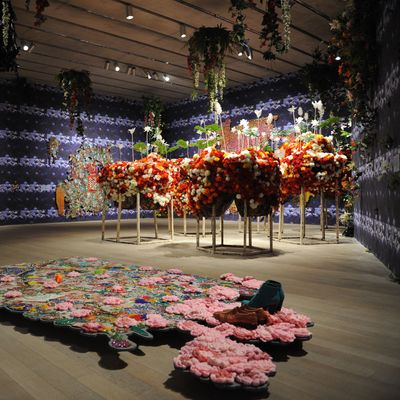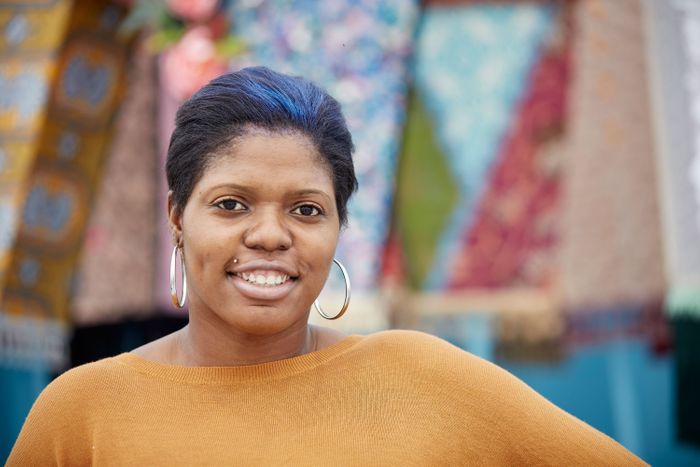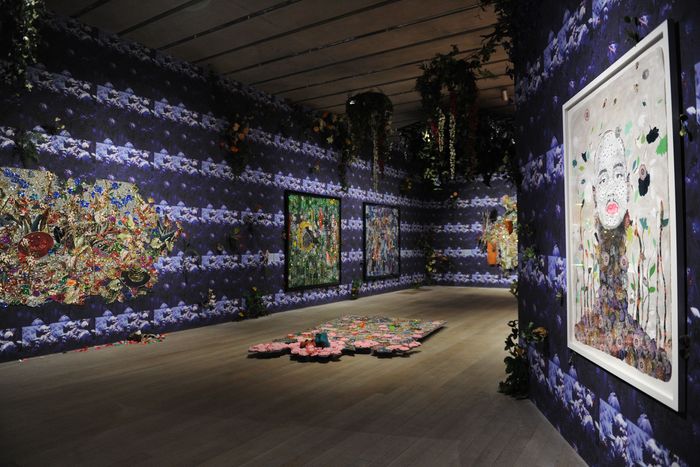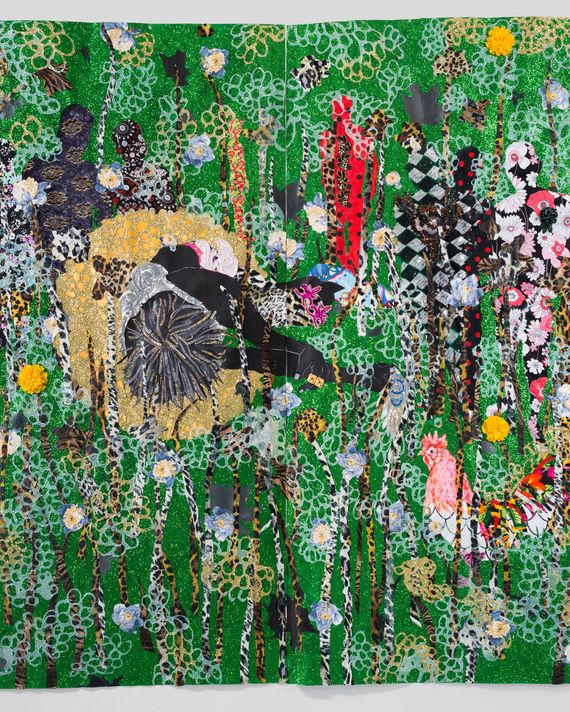
Ebony G. Patterson took the title of her Pérez Art Museum Miami exhibition, “…while the dew is still on the roses…,” from the 1912 gospel hymn “In the Garden.” “Dew in the morning time stands for revitalization,” explains Patterson, who chose the hymn for its subtly wistful depiction of a garden. “But at the same time, dew is tears.” In her garden, bliss and sorrow walk hand in hand.
For the new show, her fourth in less than a year, she created a kind of literal, if fantastical, garden inside the museum, inspired by that song. It’s also a mini survey of Patterson’s decade-long career. “I love to shift visitors’ visual and psychological experiences with a space,” she says, walking me through the museum’s galleries with clear pride. “It’s wonderful when an institution approaches and says, ‘Here is the budget — what do you want to do?’”
Her work’s meaning is often ambiguous, yet the experience is lush with suggestions of nature. Her 2015 Museum of Arts and Design installation, Dead Treez, included an array of colorful blooms inside the museum’s famous Tiffany Jewelry Gallery vitrines. Her more recent installation …called up, which featured a pool stuffed to its brim with plush toys and candles, was staged as a part of Kansas City’s “Open Spaces” biennial this past summer. Seeing this work, I was struck by how joyful it looked; however, only later, I learned that the work was installed inside a hydrotherapy pool built in the 1950s for children with skin diseases. “The pool was barren and needed to be revived,” she recalls, describing the abandoned pool almost like a body brought back to life.
Patterson lives both in her hometown Kingston, Jamaica, and Lexington, Kentucky, where she moved in 2007 for a teaching position she longer holds at the University of Kentucky School of Art and Visual Studies, though she’s often traveling. “I feel anchored living in Jamaica; it is crucial for my own sustenance,” she says of living outside of one of the big art centers. (She went to graduate school in St. Louis, at Sam Fox School of Design & Visual Arts.) Then why stay also anchored in Kentucky? “Living in two places lets me bend and reimagine things in a way I am not sure if existing in one place would allow.”
The Miami show is equally divided between her older and newer works, starting with her first video, The Observation: The Bush Cockerel Project, A Fictitious Historical Narrative from 2012. The video depicts two gender-and racially-ambiguous figures living in a fictitious wilderness, in Patterson’s words, “completely divorced from social and cultural impositions.” One figure wears predominantly white attire in stark contrast to the other’s black outfit. People tend to assume the white figure is female and the black figure is male, she says. This ambiguity is crucial for Patterson. She determines only an environment — which she blankets with intricate beauty — and otherwise lets viewers reach their own conclusions.
“…while the dew is still on the rose…” is built as a fantastical nocturnal garden, which houses the exhibition’s 12 works spanning tapestry, drawing, and video. A black fabric wallpaper, chosen to suggest night, blankets the entire gallery with an image of a bouquet of dying flowers in addition to the sound of chirping birds surrounding the space. The whimsy of her approach sugarcoats her harsh subject matter: racial segregation, class struggle, and gender inequality. “There is beauty in how people who face obstacles continue to exist in defiance to those hardships with mundane but beautiful objects.”
Patterson’s garden at Pérez is planted with silk plants, including poppies and birds-of-paradise, suspended from the ceiling and scattered around the floor. Patterson told me some of them are replicas of poisonous flowers. The show is a waltz between death and beauty: Body parts made out of frosted glass are partially buried here and there, too. “This garden has its own life, untamed and growing wild. There is so much muchness,” she says.
The exhibition in Miami ends with Patterson’s most recent video installation, Three Kings Weep, three ceiling-to-floor projections, each showing a different young man naked, crying, from the waist up. The video moves slowly to a Claude McKay poem, titled “If We Must Die,” read by a young child. “If we must die, let it not be like hogs / Hunted and penned in an inglorious spot,” the poem starts. As the men cry, they get dressed. The installation occupies a tall nook converted into a church-like setting with dramatic video projections and actors’ saintly presence. Her depiction of black bodies both as resilient and vulnerable subjects — entirely covered in her very first video and stripped off their clothes in her latest — conveys the bittersweet joy of survival against adversity, as rendered in McKay’s poem.
“My next ambition,” says Patterson, “is to create a real garden — I don’t know where yet but it’s going to happen. It’ll definitely have other things in it, creepy things.”




